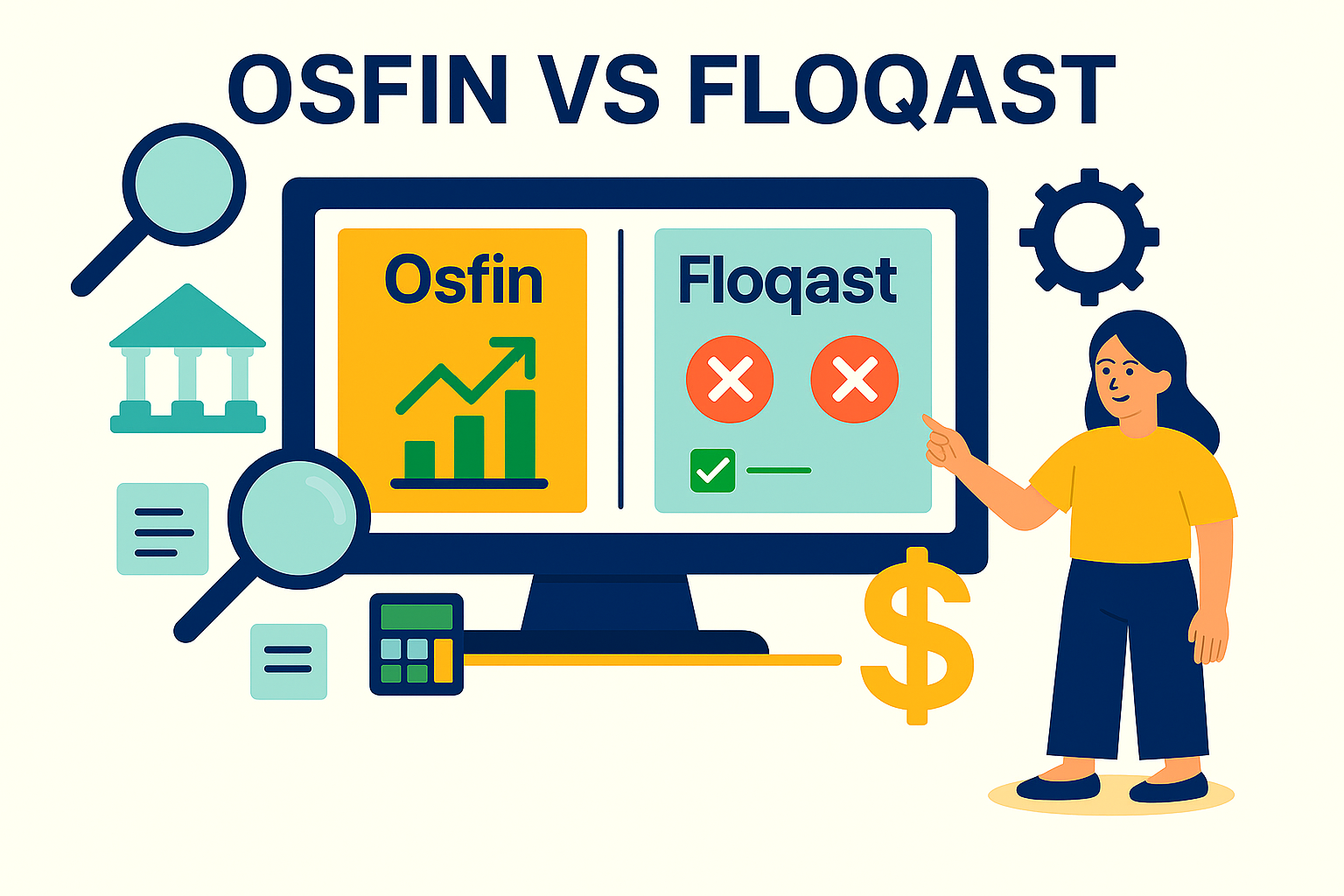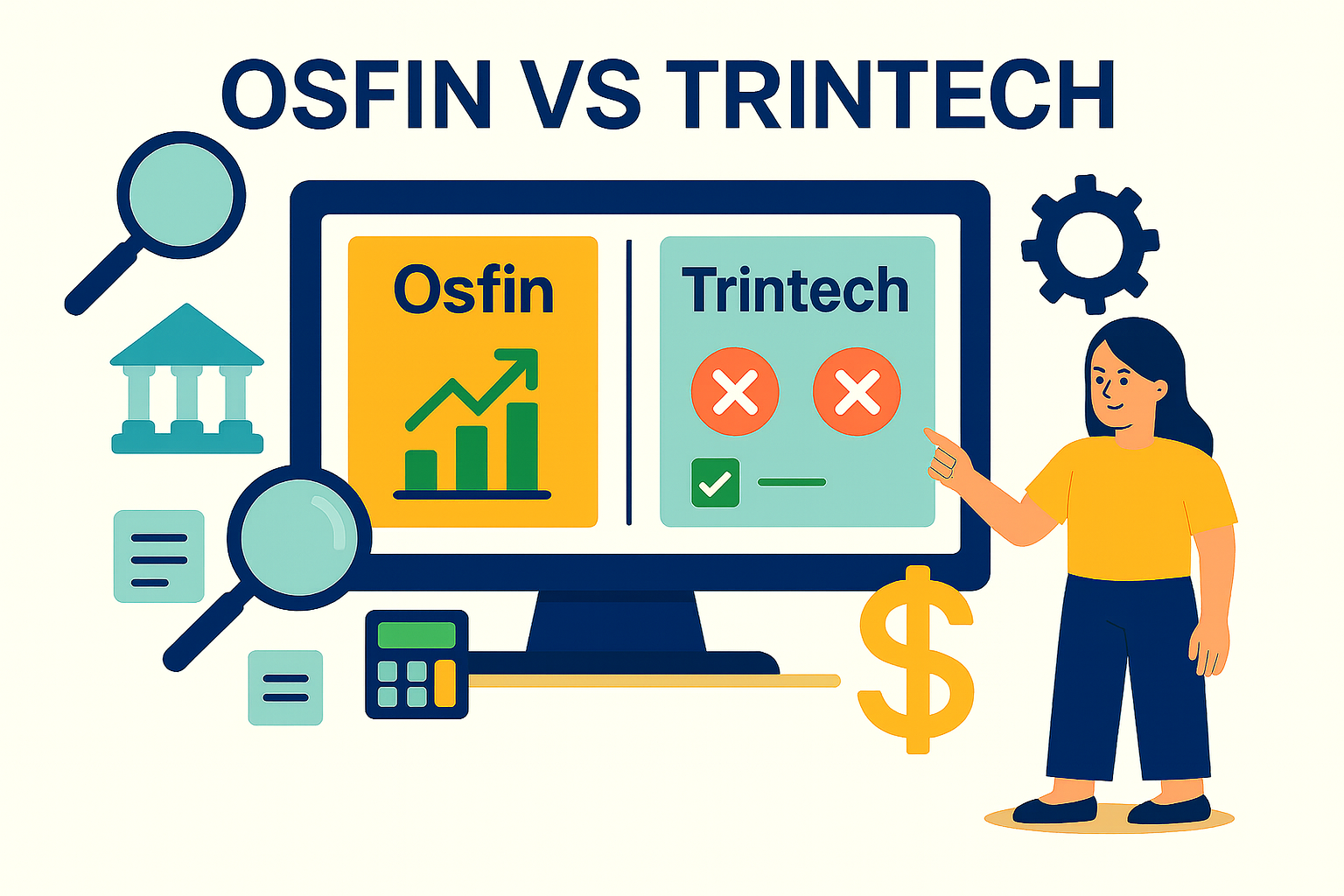What Is Record to Report (R2R) in Finance? Process, Benefits, and Tools
In enterprise finance, speed and precision are critical. When stakes are immensely high, keeping your financial foundation clean and grounded is of essence. A tool that frequently comes up in this context is the Record to Report process.
R2R brings structure to how financial data flows through your organization. It acts as the invisible infrastructure powering investor confidence, boardroom clarity, and regulatory accuracy. But to unlock its full potential, you need more than just periodic journal entries. You need a seamless, scalable, and intelligent R2R process.
Let’s discuss record to report meaning, critical record to report activities, examples, and processes. In addition, we’ll look at an automation tool that takes the legwork out of R2R – Osfin.
What this blog covers:
- What the Record to Report (R2R) process is and why it’s vital
- Key stages of R2R: transaction capture, reconciliation, close, and reporting
- Major benefits of optimized R2R: faster closes, better accuracy, audit readiness
- Common challenges in R2R workflows and how to avoid them
- How automation and tools like Osfin transform the R2R process
- Frequently Asked Questions on Record to Report (R2R)
What is Record to Report (R2R)
Record to Report (R2R) is the end-to-end finance process that turns raw transactional data into clear financial statements and insights you can actually use. It collects, validates, and transforms data into accurate statements your team can trust. Modern R2R goes beyond bookkeeping as it uses AI, automation, and real-time data integration to enable continuous, real-time closing, audit readiness, and data-driven decision-making.
The record phase documents all financial activities of an organization or a business. The report phase condenses these into documents that help evaluate financial health and operational efficiency, and overall compliance.
In finance, R2R is critical for generating accurate financial insights. It connects what’s happening on the ground, with every transaction. With a proper R2R process in place, financial organizations are equipped to make timely, data-driven decisions.
Why does Record to Report (R2R) matter in finance?
Record to Report (R2R) matters because it gives finance teams a single source of financial truth faster. It connects every transaction, cuts down on manual work, and turns close cycles from a slog into a real-time flow of insight. Today, R2R isn’t just about staying compliant, but it’s how modern finance teams actually run the business and drive smarter decisions.
- You can’t steer a company on data that’s two weeks old. R2R gives leadership a live feed of financial truth. The pulse that drives every strategic move.
- Every decimal affects trust with auditors, investors, and the board. R2R hardens that trust through automation, reconciliation, and a traceable audit trail that never sleeps.
- The old close cycle burns weekends and people. Modern R2R replaces chaos with cadence, instilling a steady rhythm of control and clarity.
Importance of R2R in financial management
What does record to report mean for financial management?
To reiterate, a strong record to report process is essential for ensuring financial balance of an organization. The impact of this process on financial processes and their management is manifold:
1. Epowers decision making with accurate data:
It ensures data accuracy through comprehensive and timely data collection and validation procedures. This clean data is fed through organizational ERP platforms and tools, and having reliable financial data is critical in the long run.
2. Accelerates momentum:
It accelerates financial close cycles, enabling timely monthly, quarterly, and annual reporting.
3. Compliance readiness:
It supports both audit readiness and regulatory alignment. Organizations are able to maintain a traceable financial trail, and comply with the ICFR framework, aligning with both domestic and international accounting standards and regulations.
4. Financial transparency:
R2R connects data from every ledger, ERP, and business unit into one clear view of financial health. This transparency builds trust with executives, investors, and auditors alike.
In short, R2R strategically enables compliance, transparency, and informed decision-making.
{{banner1}}
Key Components of the Record to Report Process Flow
Rather than being a standalone task, R2R is an interconnected process. Each step builds on the previous one. Here are the typical record to report process steps:
1. Transaction Capture and Validation:
The workflow begins with data collection and recording. All transactions, invoices, and financial documents pertaining to a defined time period are gathered, ensuring that no financial activity goes unaccounted for. This data is then categorized, coded and balanced, and recorded through journal entries.
2. Reconciliation:
Financial data within the accounts are reconciled with complementary documents, like bank statements and invoices, to ensure that balances are complete and correct.
3. Report Preparation and Analysis:
The reconciled data is now gathered and consolidated to create financial reports. Key statements like income statements, balance sheets, and cash flow statements are included here, and analyzed for trends and KPI values. Ultimately, this supports finance data-driven decision making.
4. Close Activities:
As the reporting period ends, closing tasks like intercompany eliminations, final adjustments, and compliance checks are performed.
5. Audit and Evaluation
The final stage involves internal or external audits to evaluate the accuracy, consistency, and compliance of the entire record to report process. It’s also an opportunity to evaluate your financial governance.
Since each phase is dependent on the accuracy and timeliness of the prior, bottlenecks or errors at any stage can delay the entire close and reporting cycle.
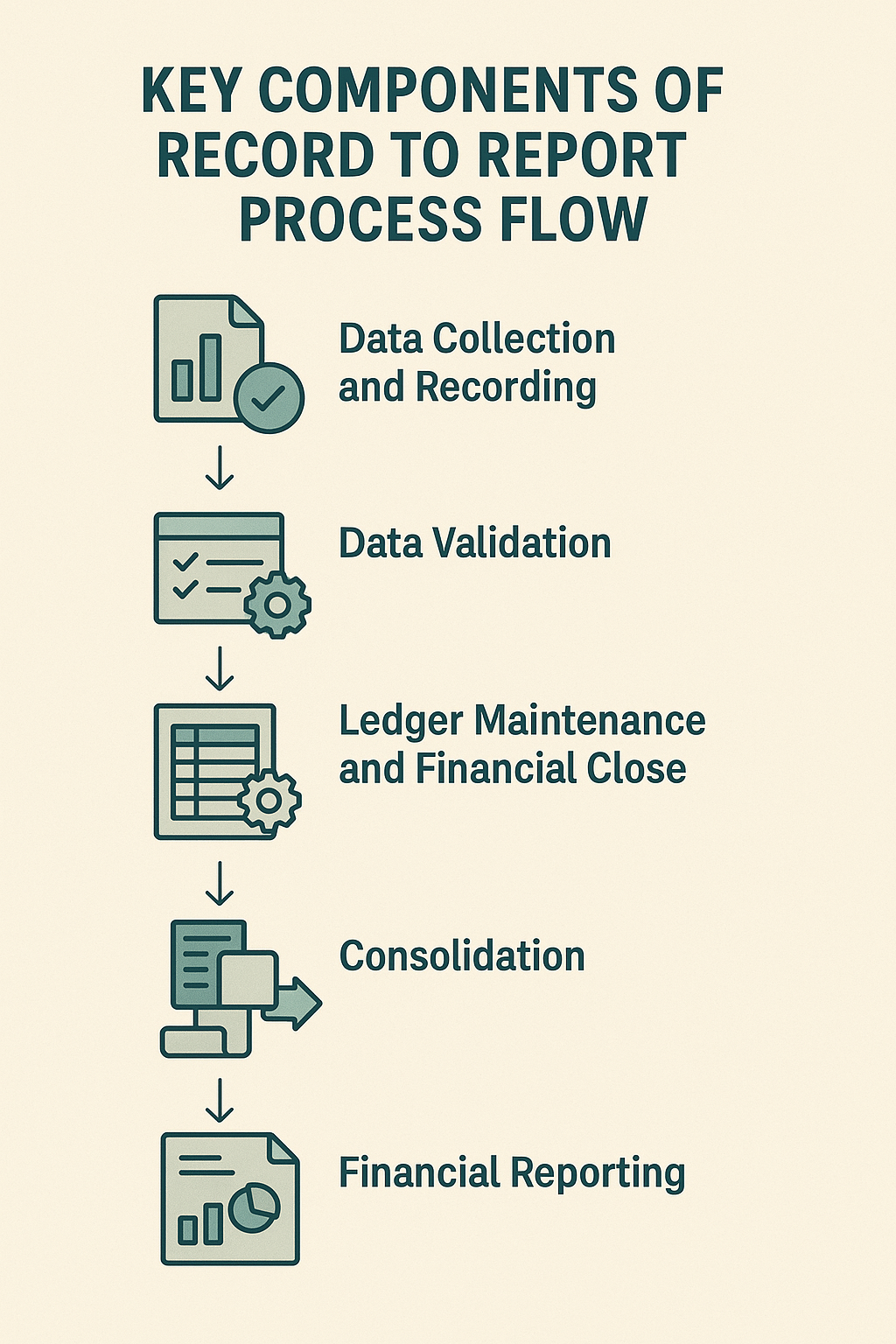
{{banner1.1}}
Benefits of an Efficient Record-to-Report Process
The benefits of record to report accounting have been mentioned before, but let’s dive deeper. When the R2R process is well-designed and effectively executed, it becomes a powerful tool for any organization. Here’s how:
1. Accelerated Close Timelines:
Organizations enjoy much shorter month-end and year-end cycles. This provides stakeholders and management personnel with time buffers for critical decision making.
2. Improved Data Accuracy:
R2R keeps your finance data clean, consolidated, and ready for use. Adding automation to the mix reduces the need for manual corrections. Cleaner data, in turn, enables more reliable reporting.
3. Enhanced Audit Readiness:
As a by-product, an R2R process creates strong controls and traceability. Compliance with regulatory standards is indispensable for any organization, and a simplified audit prep never hurts.
4. Operational Efficiency:
Last – standardized workflows and automated reconciliations increase efficiency in many arenas: lower overhead, reduced risk of delays or errors, timely reporting.
A well-optimized R2R process can transform finance into a proactive, insight-driven function.
{{banner2}}
Common Challenges in the Record-to-Report (R2R) Process
Even with years of digital transformation, most finance teams are still fighting the same battles. The close takes too long. Data lives in silos. Controls get lost in the chaos. The real issue isn’t just systems or spreadsheets. It’s the friction, operational and cultural, that keeps finance reactive instead of real-time.
1. Manual work still dominates.
The processes of most teams are rife with manual busywork. Tasks like reconciliation, data entry, and seeking approvals span across multiple email threads and spreadsheets, only multiplying the chaos. Battling this fragmentation costs 30-40% of the bandwidth and introduces new errors.
2. Data remains fragmented.
Fragmented data across multiple ERP systems hinders the right judgment and decision-making, as it hides critical insights and the complete picture.
3. Technology gaps persist.
ERPs manage transactions but not end-to-end orchestration. Point solutions automate fragments while leaving critical steps manual.
4. Compliance lacks consistency.
Control ownership and audit readiness often sit outside daily workflows, creating last-minute pressure at quarter-end.
5. Change resistance limits progress.
Even with strong technology, adoption lags when teams lack training, confidence, or cultural alignment with automation.
Key Record to Report Activities
There are several moving parts within a robust record to report business process:
1. General Ledger:
The general ledger holds the breadth of financial information (revenue, assets, liabilities, and more). Your teams rely on this compendium to build accurate reports and stay audit-ready.
2. Sub-ledgers:
Sub-ledgers feed into the general ledger, and maintain relevant information on data entries within it. They offer a clear view of where each data point in your financial system comes from.
3. Enterprise Data Sources:
Next, information comes from a variety of business systems (ERP software, payroll platforms, supply chain softwares). These systems record what's happening on the ground and are another important part of the R2R process.
4. Automation Tools:
Manual reconciliation is both time consuming and error prone. Automation tools like Osfin help streamline everything from data collection to validation.
5. Reporting Software:
Once the data’s been verified, reporting tools help create compliance reports and performance dashboards that drive smarter decisions.
Why Automating Record to Report Is Crucial
As finance operations become more complex, manual R2R becomes inadequate.
The common thread in all manual recording and reconciliation processes does more harm than good. The use of disconnected systems, excessive spreadsheets, and informal communication channels often leads to unorganized financial operations.
Automation enables record to report process transformation. It addresses these challenges by consolidating financial data from various sources into a single, centralized platform. It also reduces errors through built-in validations and exception handling. Users of automation tools enjoy real-time visibility into close activities via dashboards and alerts. Additionally, automated systems simplify audit readiness.
By streamlining these core R2R tasks, organizations can shorten reconciliation, improve data accuracy, and enhance financial governance. The case for automation builds itself.
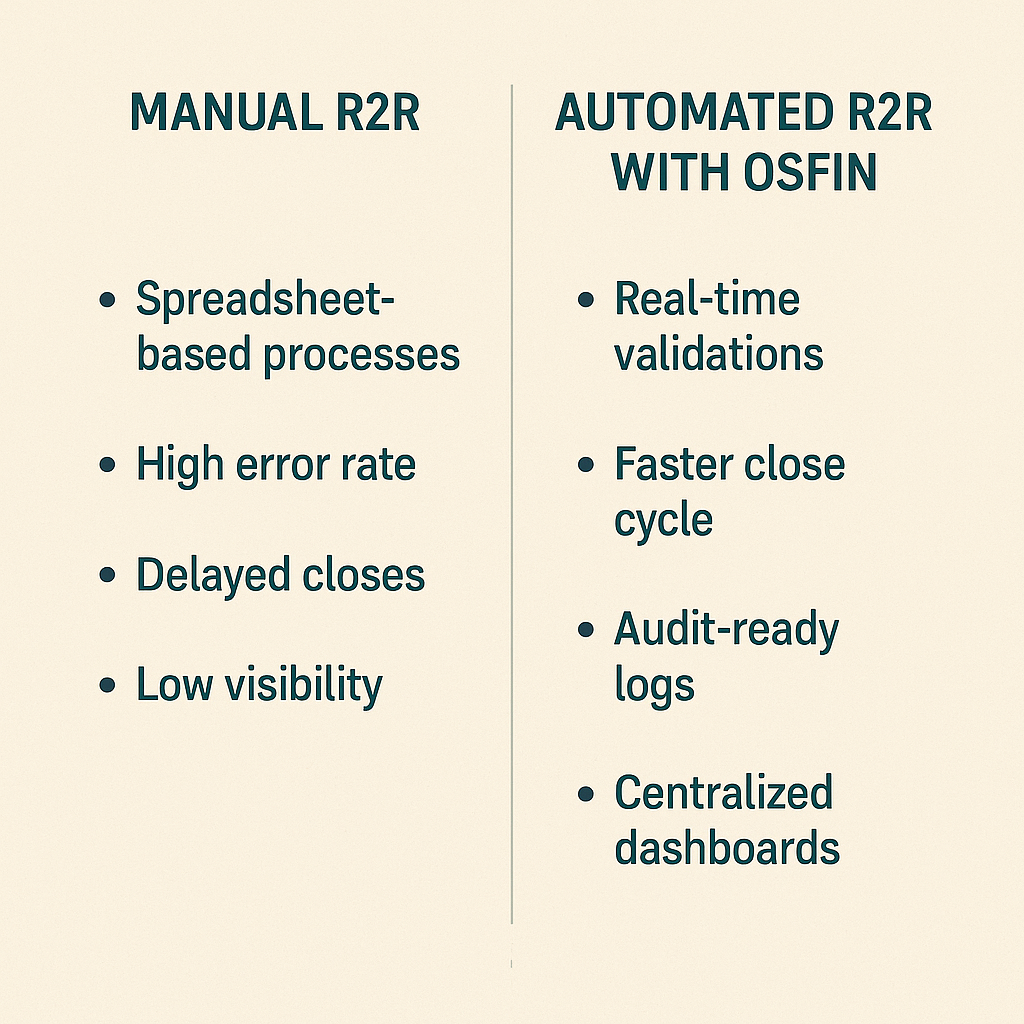
{{banner2.1}}
Record to Report Best Practices
Top-performing finance teams follow a structured approach towards their record to report process flow. Here’s what we have learned :
- Maintain a consistent chart of accounts and journal entry framework across business units.
- Assign clear responsibilities for each phase of the close to avoid delays and confusion.
- Reconcile accounts throughout the period instead of waiting until for the D-day.
- Streamline recurring entries and tasks using automation tools like Osfin.
- Regularly monitor indicators like close duration, reconciliation backlog, and posting errors.
- Use dashboards and reporting tools to track progress and spot exceptions in real time.
Common Pitfalls in R2R Transformation
With its highs, come its lows. Many organizations face roadblocks that can derail R2R if left unaddressed:
- Relying on outdated manual processes is a pitfall by itself. The risks of manual errors and oversights run large, and automation is the need of the hour in such scenarios.
- Fragmented data distribution can make it difficult to record your financial data in an organized, time-sensitive manner.
- Any workflow or data format inconsistencies in your organization can add days to weeks to your R2R process.
- It’s important to conduct personnel training on a standardized R2R procedure.
Being proactive in R2R transformation can have immense benefits for your financial reconciliations and operations. Let’s talk about this in the next section.
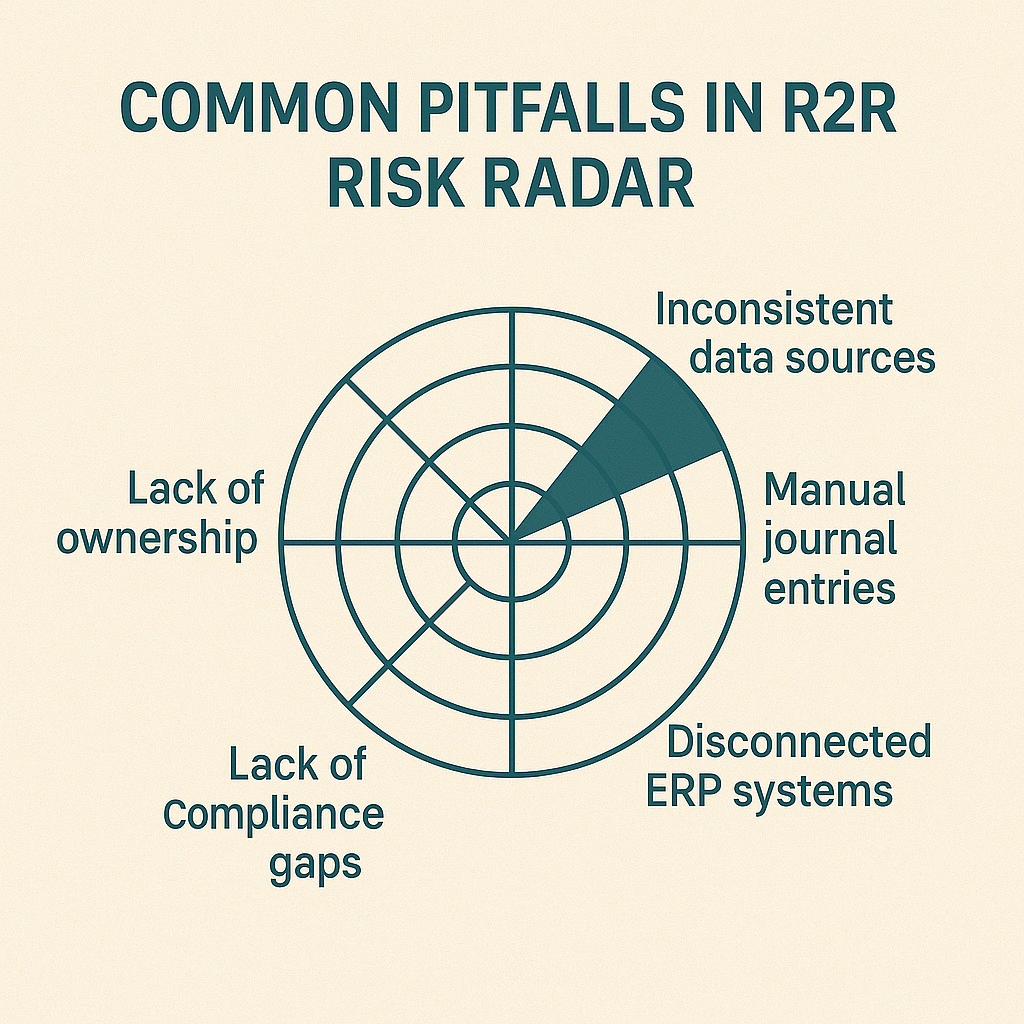
Why R2R Is Core to Scalable Financial Operations
What exactly makes R2R so important for scaling businesses?
As businesses expand, the complexity of financial operations increases. New data format, data size, data locations, all stand in the way of seamless financial reporting. Here, a scalable R2R process is critical for keeping pace:
- Rapid onboarding of new entities, systems, and geographies without disrupting reporting cycles
- Support for multi-currency reporting ensuring global compliance
- Efficient reconciliation even as transaction volumes increase
- Standardized processes and internal controls across regions and business units
- Data readiness for enterprise-wide planning, forecasting, and analytics
Of course, record to report process outsourcing to automation tools is a logical next step. Let’s see how it helps.
{{banner3}}
Record to Report Process Transformation with Osfin
With the importance of both automation and efficient R2R in mind, let’s combine both.
Osfin brings next-generation automation and intelligence to the R2R process. Here’s a subset of Osfin’s tool kit:
- Osfin automates transaction matching across bank statements, ledgers, ERPs, and clearing files, including the reconciliation pertaining to gateway fees, taxes, and settlements, streamlining key steps in the R2R process.
- It flags duplicates and anomalies during data ingestion, with real-time exception tagging and intelligent routing.
- Osfin provides live visibility into match status, breaks, and financial exposure through intuitive dashboards.
- Compatible with 170+ ERPs, processors, and banking systems. Supports major formats like MT940, ISO 20022, CSV, JSON, and XML.
- Osfin Includes role-based access, encryption, and two-factor authentication for robust data protection.
- Supports SOX controls with full audit trails and adheres to SOC 2, PCI DSS, ISO 27001, and GDPR standards.
- You can set up custom rules, tolerances, and workflows using a user-friendly no-code builder. Osfin lets you go live quickly with support from finance and reconciliation experts.
Osfin helps finance teams replace fragmented workflows with a unified, intelligent R2R system. Now, it’s your turn to explore how Osfin can streamline your R2R, end-to-end.
{{banner3.1}}
Future of R2R with AI-powered continuous accounting
We’ve automated payroll, invoicing, and forecasting, yet somehow, month-end still feels medieval. That’s what AI is finally changing.
Continuous accounting is the moment finance stops reporting the past and starts operating in real time.
Here’s what the future of R2R with AI looks like:
1. From month-end close to real-time clarity
AI-driven workflows keep finance teams ahead of the numbers. They reconcile, validate, and refresh data in real time, giving leaders live visibility into performance. No waiting for the month to end, just continuous clarity, faster close cycles, and confident, data-driven decisions every day.
2. AI agents replace manual orchestration
Specialized agents handle reconciliations, journal entries, and anomaly detection autonomously. Finance professionals shift from executing tasks to directing intelligent systems.
3. Continuous compliance becomes the norm.
Every entry, approval, and variance check is logged automatically. Instead of racing to meet audit deadlines, organizations maintain audit readiness every single day.
4. Decision-making moves to real time.
Leadership doesn’t usually wait for reports, they just act on live dashboards showing performance, cash flow, and risk exposure across entities.
5. Finance transforms into a strategic command center.
Continuous accounting unifies R2R, FP&A, and GRC into a single flow of truth. The CFO’s role expands from financial custodian to intelligence architect, empowering them to do what they are meant to do, guiding the business with data that never sleeps.
FAQs on Record to Report (R2R)
1. What does Record to Report means in finance?
Record to report’s definition is the end-to-end finance process that transforms raw transactional data into formal financial reports. It ensures that every financial activity is accurately captured, processed, and presented for internal and external stakeholders.
2. What are the steps involved in the R2R process?
Key steps in the record to report process include recording transactions, reconciling, posting journal entries, preparing documentations and matching balances, then actually executing the financial close. Finally, utilizing R2R for better decision making in the long run.
3. Why is automating R2R important?
Automating R2R improves speed, accuracy, and compliance. It reduces manual effort, flags anomalies early, standardizes processes across teams, and creates reliable audit trails—freeing finance teams to focus on analysis, not administration.
4. What’s an example of a record to report in action?
A record to report example can be when a multi-store retailer collects sales data daily from its POS systems. This data is reconciled against bank deposits, adjustments are posted, and accurate financials are prepared at month-end to reflect business performance.
5. What are the challenges in record to report accounting?
The typical challenges of R2R include the presence of fragmented data across systems, lack of properly executed automation, differences in processes dealing with the financial data, and a lack of standardization, controls, and check points.
6. What is the difference between R2R and P2P (Procure to Pay)?
The difference between R2R and P2P is in the use case. P2P is about managing the lifecycle of supplier spend, while R2R is a report that captures what’s spent. This ensures accurate financial statements and transparent records.
7. How often should R2R be performed?
Typical cycle for R2R is monthly for core reporting, quarterly for governance purposes, and annually for strategic reporting.
8. What’s the role of R2R in audit compliance?
R2R brings transparency and accuracy across the accounting. Along with that, it also makes everything traceable and verifiable, which helps a lot to stay audit-ready. It’s something that ties every transaction to the right account and keeps the audit trail that auditors like to see.
